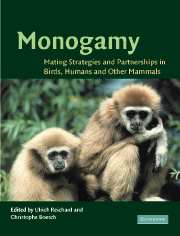Book contents
- Frontmatter
- Contents
- List of contributors
- Acknowledgements
- Introduction
- PART I Evolution of social monogamy
- CHAPTER 2 The evolution of monogamy: mating relationships, parental care and sexual selection
- CHAPTER 3 Mate guarding and the evolution of social monogamy in mammals
- CHAPTER 4 The evolution of social monogamy in primates
- CHAPTER 5 The evolution of social and reproductive monogamy in Peromyscus: evidence from Peromyscus californicus (the California mouse)
- PART II Reproductive strategies of socially monogamous males and females
- PART III Reproductive strategies of human and non-human primates
- Index
CHAPTER 3 - Mate guarding and the evolution of social monogamy in mammals
Published online by Cambridge University Press: 05 July 2014
- Frontmatter
- Contents
- List of contributors
- Acknowledgements
- Introduction
- PART I Evolution of social monogamy
- CHAPTER 2 The evolution of monogamy: mating relationships, parental care and sexual selection
- CHAPTER 3 Mate guarding and the evolution of social monogamy in mammals
- CHAPTER 4 The evolution of social monogamy in primates
- CHAPTER 5 The evolution of social and reproductive monogamy in Peromyscus: evidence from Peromyscus californicus (the California mouse)
- PART II Reproductive strategies of socially monogamous males and females
- PART III Reproductive strategies of human and non-human primates
- Index
Summary
INTRODUCTION
The majority of hypotheses proposed to explain the evolution of social monogamy focus on the benefits of biparental care to offspring (e.g., Kleiman, 1977; Wittenberger & Tilson, 1980). This is probably for two reasons. First, most socially monogamous fish, birds and mammals show some form of biparental care; indeed, this association is so close that many early authors included biparental care in their definitions of monogamy (e.g., Lorenz, 1963, p. 167; Lack, 1968, pp. 4-5; Brown, 1975, p. 168; Wilson, 1975, p. 589). Second, given the enormous difference that normally exists between the potential reproductive rates of the sexes (especially in mammals because of female gestation and lactation: Clutton-Brock & Vincent, 1991), it is difficult to explain why the most competitive males are unable to monopolize more than one mate, unless males are constrained by paternal commitments.
Although understandable, this emphasis on the benefits of biparental care has, we believe, shifted the focus of the debate on social and/or genetic monogamy away from its original evolution and onto its current function and maintenance. In this chapter we address this imbalance by considering the origins of social monogamy in mammals. First, we attempt to reconstruct the evolutionary routes by which social monogamy could have evolved, by considering the social and parental care systems that may have been exhibited by non-monogamous ancestors.
- Type
- Chapter
- Information
- MonogamyMating Strategies and Partnerships in Birds, Humans and Other Mammals, pp. 42 - 58Publisher: Cambridge University PressPrint publication year: 2003
- 67
- Cited by



